HGST Deskstar NAS 6 TB Review
by Ganesh T S on December 23, 2014 11:00 AM ESTRAID-5 Benchmarking - Miscellaneous Aspects
Consumers are rightly worried about RAID rebuilds and the scope for drive failures during that process. As one of our evaluation aspects, we randomly yanked out a disk during operation and cleaned it up for rebuild. We recorded the resync duration (time taken to rebuild a 3-disk RAID-5 volume when one of the disks needs to be replaced) as well as the average power consumption during that process. The two aspects, considered together, give an idea of the efficiency of the hard drive. The graph below presents the total energy consumption (Resync Power Consumption (W) X Resync Duration (s)) for the resync.
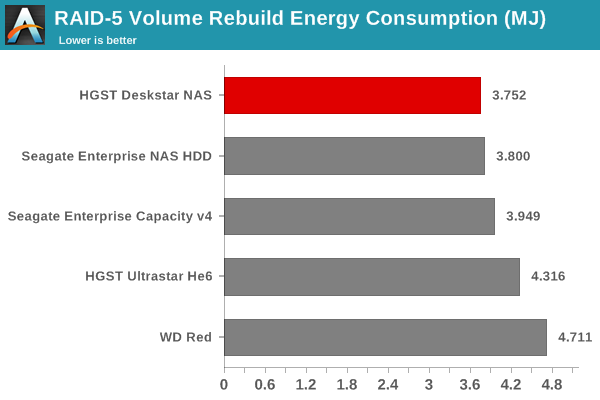
While the energy consumption aspect provides a consolidated view of the various factors, it is still worthwhile to look at the power consumption and resync duration numbers separately. The table below provides the raw information behind the above graph. We had a brief inkling when the temperature of the Deskstar NAS remained around 40 C only, despite more than 240 GB of continous data traffic, but the above energy consumption numbers confirm the fact that the Deskstar NAS is indeed quite efficient. That said, the raw power numbers do not look good for the Deskstar NAS in the table below. However, by getting done with the workloads earlier, the drive can go to the idle state quickly and keep system energy consumption resonable in the long run.
| RAID-5 Resync Power Consumption & Duration | ||
| Drive | Power (W) | Duration (s) |
| HGST Deskstar NAS | 101.46 | 36981 |
| WD Red | 90.48 | 52072 |
| Seagate Enterprise NAS HDD | 101.91 | 37284 |
| HGST Ultrastar He6 | 95.36 | 45260 |
| Seagate Enterprise Capacity v4 | 105.42 | 37462 |
We also measured power consumption during the last stage of our multi-client test. With 25 different clients simultaneously stressing the NAS with different types of workloads, we recorded the power consumption at the wall for the NAS as a whole. The various numbers are presented in the graphs below.
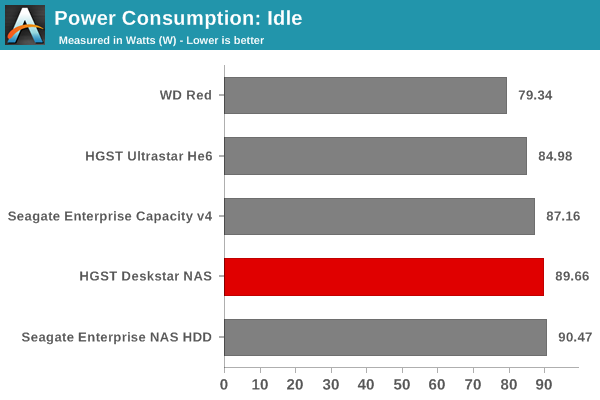
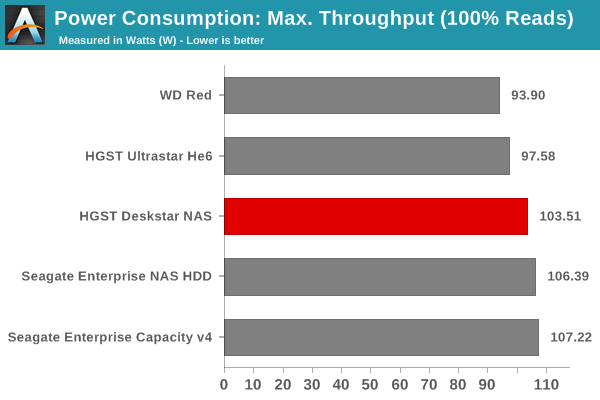
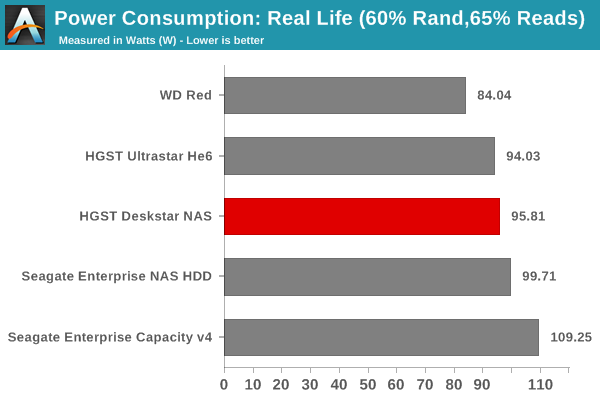
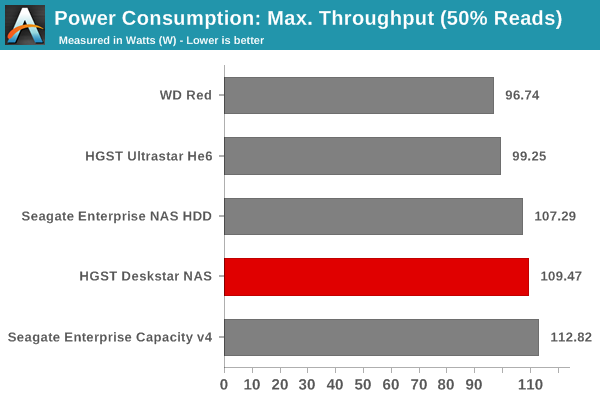
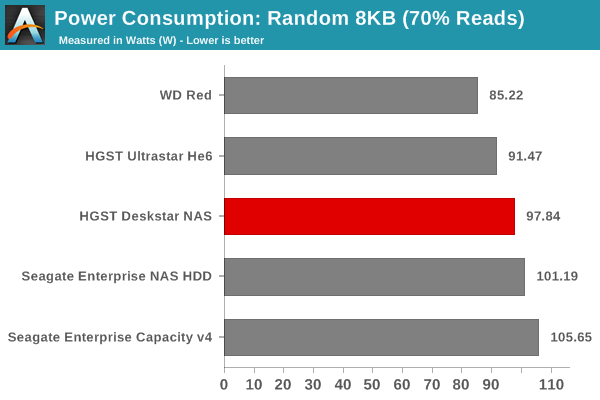
As expected, the units providing better performance have higher power consumption numbers. Amongst the 7200 RPM drives, the Ultrastar He6 is the most power-efficient. This is due to the HelioSeal technology (disks spinning in a sealed chamber filled with helium). Amongst the conventional drives, the Deskstar NAS manages to be the most power efficient for a few of the access patterns.










36 Comments
View All Comments
Laststop311 - Thursday, December 25, 2014 - link
Price/reliability/performance I think this is the best series of drives to purchase.akula2 - Saturday, January 3, 2015 - link
You're absolutely correct. I own many Hitachi drives compared to WD and Seagate models.realwarder - Friday, December 26, 2014 - link
I purchased two of these and put them in a Dell server as RAID drives. It was curious to read about the Qnap IO error as the drives failed to operate correctly in the server to start with - when on SATA channel 2/3 they always got an IO error during the boot which caused Windows Storage Spaces to reject the drives. On moving to channel 0/1 they show no I/O error at boot and work fine.Once working, they appear ok if not a little noisy. Run 4 degrees warmer than the boot drive too.
Only time will tell how they work out, but it's a lot of fast space which is what I was after - just look a lot of pain to get working due to the IO error causing the drive rejection.
StevieBee - Friday, December 26, 2014 - link
Some advice please folks.. I have 2x8 bay synology drives ( 1815+) which i use for SOHO file backup and some media on a very small network of 3 users. At the moment i have 5 3TB WD reds in each and i want to add another 3 drives to each.My question is what are the best drives to add to the array? Reliability is more an issue than cost.
I was at first thinking about WD red Pro, but i am worried that the higher speed than my existing reds would cause a problem...Will it?
The other alternative would be to make one unit all the new deckstars with the higher speed, and then use the old WD reds to increase the other unit.
Any advice would be greatly appreciated.
Merry Christmas
Steve
intiims - Friday, December 26, 2014 - link
Great review from a great site. Nice Products Spec tables, very usefull and easy to understand.Guspaz: I think little and fast SDD drives are much better than big and slow, by the way, who can fill up 8TB ? I have never ever got more than 1TB. Even with a lot of movies and photos..
I found i nice site witth great reviews:
http://hddex.blogspot.com/
akula2 - Saturday, January 3, 2015 - link
@However, the HGST Deskstar NAS drives have a 7200 RPM rating and the 5 / 6 TB variants come with 128 MB of DRAM cache. This is expected to make them perform closer to the Seagate Enterprise Capacity v4 and Enterprise NAS HDD drives.Ganesh, that's a wrong comparison. Deskstar HDDs are targeted at Consumer or SOHO or even SMB segment. Why? Because it gets quite easy to go for RAID by adding a few HDDs in the Cases. Rest is all known.
If folks (like me) looking for Enterprise-grade drives, go for Hitachi's SAS 12 GB/s HDDs to get very high performance and ultra reliability. One can even choose SATA III HDD drives too. Most important is to know when to use those models. E.g.,
a) Hitachi Ultrastar 7K6000 SAS 12Gb/s - 6 TB, 7200, 128 MB HDD
b) Hitachi Ultrastar 7K6000 SATA 6Gb/s - 6 TB, 7200, 128 MB HDD
c) Hitachi Deskstar NAS SATA 6Gb/s - 6 TB, 7200, 128 MB HDD
Those three drives may look more or less same, but they aren't!